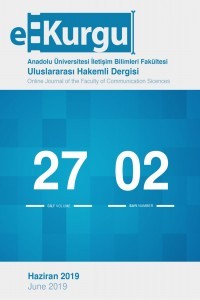Alternatif Medy ayl a Öğretmek
Alternatif medya, eleştirel medya okuryazarlığı, kültürel politikalar, gazetecilik, ekonomi politik
Teaching With Alternative Media
Alternative media, critical media literacy, cultural politics, journalism, political economy,
___
- Atton, C. (2002). Alternative media. London: Sage.
- Barsamian, D. (1992). Stenographers to power: media and propaganda. Monroe: Common Courage Press.
- Chomsky, N. & Herman, E. (1988). Manufacturing consent: The political economy of media. New York: Pantheon.
- Cohen, J. & Solomon, N. (1998). Adventures in medialand: Behind the news, beyond the pundits. Monroe: Common Courage Press.
- Couldry, N. & Curran, J. (2003). Contesting media power: Alternative media in a networked world. Lanham: Rowman & Littlefield.
- Downing, J. (2001). Radical media: rebellious communication and social movements. Thousand Oaks: Sage.
- Huesca, R. (2002). Integrating teaching and educational cable to enrich the community, campus, and students. Community media review, 25(2), 24-25.
- Independent media in a time of war. Produced by Hudson-Mohawk IMC, 2003.
- Kellner, D. & Share, J. (2005). Toward critical media literacy: Core concepts, debates, organizations, and policy. Discourse: studies in the cultural politics of education, 26(3), 369-386.
- Kidd, D. (2003). Become the media: The global IMC network. In A. Opel, & D. Pompper
- (Eds.) Representing resistance: media, civil disobedience and the global justice movement (224- ). Westport, CT: Praeger. Lewis, J. & Jhally, S. (1998). The struggle over media literacy. Journal of communication, (1), 109-120.
- Masterman, L. (1985/2001). Teaching the media. New York: Routledge.
- McCall, J. (2007). Viewer discretion advised. Lanham: Rowman & Littlefield.
- McChesney, R. W. (2004). The problem of the media: U.S. communication policy in the 21st century. New York: Monthly Review Press.
- Potter, J. W. (1998). Media literacy. Thousand Oaks, CA: Sage.
- Rendell, S. and Broughel, T. (2003). ‘Amplifying Officials, Squelching Dissent’. Extra FAIR
- May/June. Available: http://www.fair.org/index.php?page=1145 (Accessed 22 August 2009).
- Sholle, D. & Denski, S. (1994). Media education and the (re)production of culture. Westport, CT: Bergin & Garvey.
- This is what democracy looks like. Directed by Freidberg, J. & Rowley, R. Seattle IMC & Big Noise Films, 2000.
- Torres, M. & Mercado, M. (2006). The need for critical media literacy in teacher education core curricula. Education Studies, 39(3), 260-282.
- White, S. (ed.) (2003). Participatory video: Images that transform and empower. New Delhi: Sage.
- ISSN: 1309-3487
- Başlangıç: 2014
- Yayıncı: Anadolu Üniversitesi
Alternatif Medy ayl a Öğretmek
İletişimsel Olmayan Ortaklar: Toplumsal Hareket Medyası Analizi ve Radikal Eğitmenler
John D H DOWNİNG, Çağdaş CEYHAN
Medyada Alternatif Bir Hal: ‘AHALİ’ ve Karşıt Kamusallık
Alternatif Medya Çalışmalarının Temellerine İlişkin Eleştirel Bir Katkı
Ücretsiz Gazeteler: Türkiye ve Dünya'daki Gelişimleri Üzerine Genel Bir Değerlendirme
